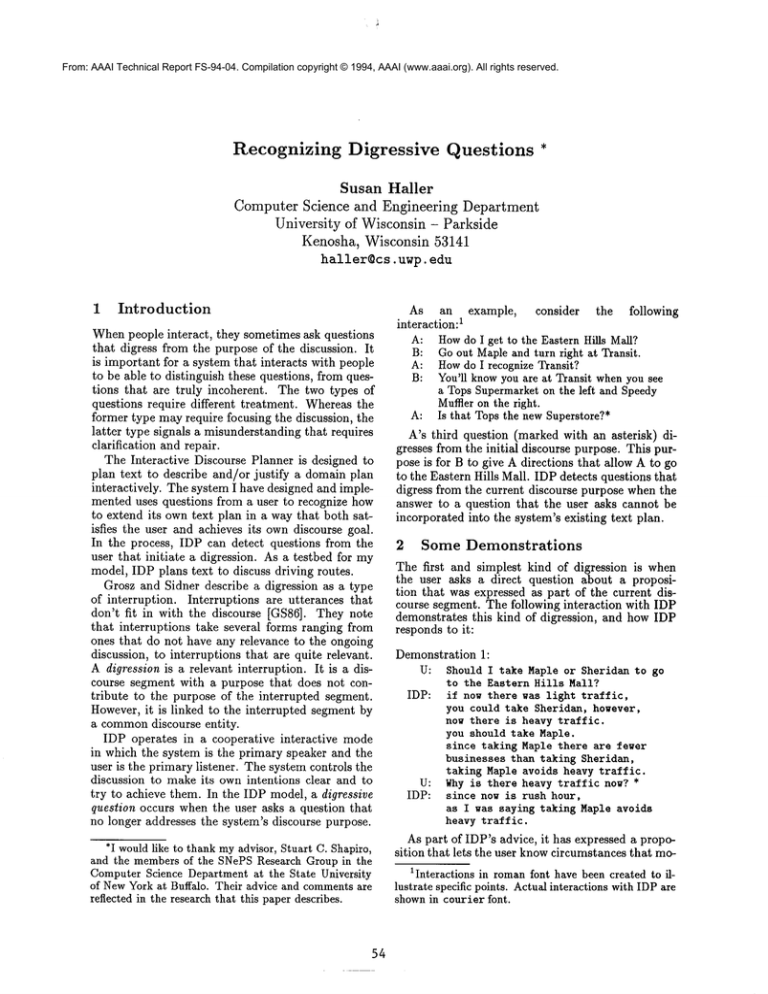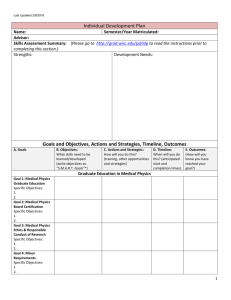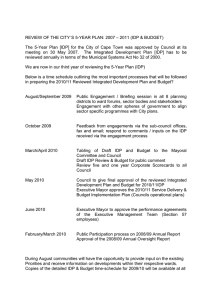
From: AAAI Technical Report FS-94-04. Compilation copyright © 1994, AAAI (www.aaai.org). All rights reserved.
Recognizing
Digressive
Questions
*
Susan Haller
Computer Science and Engineering
Department
University of Wisconsin - Parkside
Kenosha, Wisconsin 53141
hailer@as, uwp. edu
1
Introduction
Whenpeople interact, they sometimes ask questions
that digress from the purpose of the discussion. It
is important for a system that interacts with people
to be able to distinguish these questions, from questions that are truly incoherent. The two types of
questions require different treatment. Whereas the
former type may require focusing the discussion, the
latter type signals a misunderstanding that requires
clarification and repair.
The Interactive Discourse Planner is designed to
plan text to describe and/or justify a domain plan
interactively. The system I have designed and implemented uses questions from a user to recognize how
to extend its own text plan in a way that both satisfies the user and achieves its owndiscourse goal.
In the process, IDP can detect questions from the
user that initiate a digression. As a testbed for my
model, IDP plans text to discuss driving routes.
Grosz and Sidner describe a digression as a type
of interruption. Interruptions are utterances that
don’t fit in with the discourse [GS86]. They note
that interruptions take several forms ranging from
ones that do not have any relevance to the ongoing
discussion, to interruptions that are quite relevant.
A digression is a relevant interruption. It is a discourse segment with a purpose that does not contribute to the purpose of the interrupted segment.
However, it is linked to the interrupted segment by
a commondiscourse entity.
IDP operates in a cooperative interactive mode
in which the system is the primary speaker and the
user is the primary listener. The system controls the
discussion to make its own intentions clear and to
try to achieve them. In the IDP model, a digressive
question occurs when the user asks a question that
no longer addresses the system’s discourse purpose.
*I wouldlike to thank myadvisor, Stuart C. Shapiro,
and the membersof the SNePSResearch Group in the
ComputerScience Department at the State University
of NewYork at Buffalo. Their advice and commentsare
reflected in the research that this paper describes.
54
As an example,
consider
the following
1
interaction:
A: Howdo I get to the Eastern Hills Mall?
B: Go out Maple and turn right at Transit.
A: Howdo I recognize Transit?
B: You’ll knowyou are at Transit whenyou see
a Tops Supermarket on the left and Speedy
Muffleron the right.
A: Is that Tops the new Superstore?*
A’s third question (marked with an asterisk) digresses from the initial discourse purpose. This purpose is for B to give A directions that allow A to go
to the Eastern Hills Mall. IDP detects questions that
digress from the current discourse purpose when the
answer to a question that the user asks cannot be
incorporated into the system’s existing text plan.
2
Some
Demonstrations
The first and simplest kind of di6ression is when
the user asks a direct question about a proposition that was expressed as part of the current discourse segment. The following interaction with IDP
demonstrates this kind of digression, and how IDP
responds to it:
Demonstration 1:
U: ShouldI takeMapleor Sheridanto go
to the EasternHillsMall?
IDP: if now therewas lighttraffic,
you couldtakeSheridan,
however,
now thereis heavytraffic.
youshouldtakeMaple.
sincetakingMaplethereare fewer
businesses
thantakingSheridan,
takingMapleavoidsheavytraffic.
U: Why is thereheavytrafficnow7*
IDP: sincenowis rushhour,
as I was sayingtakingMapleavoids
heavytraffic.
As partof IDP’sadvice,
it hasexpressed
a proposition
thatletstheuserknowcircumstances
thatmoIInteractions
in romanfonthavebeencreated
to ~lustrate specific points. Actual interactions with IDPare
shownin courier font.
tivate it. In particular, IDPhas told the user that
now there is heavy traffic.
IDP identifies
the
user’s question (marked with an asterisk)
as a digression from its intent. Therefore, after answering
the question, IDP shifts the discussion back to its
recommendation.
A second kind of digression that IDP can detect
occurs when the user refers to a proposition that was
never expressed, but that can be inferred from the
content that is presented:
Knowledge Base
~
T
Planner-Actor
i
[ Generation
NL input
Demonstration
2:
......
--
Should I take Maple or Sheridanto go
to the EasternHills Mall7
IDP: you should take Maple.
U: Why?
IDP: taking Maple avoids heavy traffic.
U: Why?
IDP: taking Maple there are fewer businesses
than taking Sheridan.
U: Why is there heavy traffic now? *
IDP: since now is rush hour,
as I was saying taking Maple avoids
heavy traffic.
I
Grammar I
NL output
control flow
data and controlflow
U:
IDP uses its text plan to detect that the user’s
fourth question initiates
a digression.
This is
notwithstanding
the fact that IDP never expressed
the proposition that the user questions. The user’s
digressive
question relies on an inference that he
made from the proposition that IDP conveyed in its
second response.
A third type of digression occurs when the user’s
line of questioning keeps referring to the last proposition that was expressed. This eventually leads to
an explanation that does not address IDP’s original
discourse
purpose. The interaction
below demonstrates that IDP detects digressions of this kind:
Figure
EES Text Planner does not build a single text plan
[MS91]. The system analyzes questions
like Why?
using a stack of text plans from previous exchanges
and a development history provided by the expert
reasoning system. The system applies heuristics
to
these sources of information to generate a set of
likely interpretations
and select one of them.
In the IDP model, the system’s TP is treated as
a richer resource of information.
Therefore,
IDP
builds a single TP. In this respect, IDP is similar
to the Explanatory
Discourse
Generator
(EDGE)
[Caw90]. EDGEformulates
and represents
a single text plan, and uses it as the discourse context
to analyze feedback.
However, EDGEplans tutorials.
Therefore, unlike IDP, EDGEformulates its
text plan in advance and executes it incrementally.
4
4.1
Demonstration 3:
U: Should I take Maple or Sheridanto go
to the EasternHills Mall?
IDP: take Maple.
U: Why?
IDP: taking Maple avoids heavy traffic.
U: Why?
IDP: taking Maple there are fewer
businessesthan taking Sheridan.
U: Why? *
IDP: since taking Maple is a newer route
than taking Sheridan.
anyways,taking Maple avoids
heavy traffic.
Related
System
Overview
Architecture
There is a one-way flow of control though three of
the five components of IDP: the parser, the analyzer,
and the planner-actor
(Figure 1). During a complete user-system exchange, this flow starts with,
and cycles back to, the parsing component. After selecting and structuring
content, the planneractor sends a text message to a fourth component,
the generation grammar written in the Generalized
Augmented Transition
Network (GATN) formalism
[Sha82]. The same formalism has been used for the
parser. Finally, these four components all have access to a fifth, a knowledge base, which they consult
to find or deduce information.
Unlikethefirsttwo why-questions,
theuser’sthird
why-question requires an answer that cannot be incorporated into the system’s text plan for trying to
convince the user to use the Maple Road route.
3
h System Architecture
Work
Like the EES Text Planner [MSgl] IDP plans only
as needed in reaction
to feedback. However, the
55
4.2
The Knowledge
Base
In the knowledge base, the several sources of information that IDP needs to analyze and plan the
text are all represented uniformly using the Semantic
Network Processing
System (SNePS) [SR87, SG92].
This includes knowledge of the text plan operators,
the domain plans, entities
in the domain, the user
model, the text plan executed so far, and rules for
reasoning about all of the above.
4.3 The Planner-Actor
IDP’s planner-actor is based on the SNePS Actor
[SKA89]. The SNePS Actor models an agent operating in a single-agent world. The formalism integrates inference and acting by representing information about plans uniformly with other information
in the network. The system contains propositions
about plans for goals, and the preconditions, effects,
and expansions of various acts. Because the system’s
world and planning knowledge are represented uniformly, it can discuss, reason about, formulate, and
also execute its plans.
I have modified the SNePSActor in two ways to
become IDP’s planner-actor. First, when presented
with a choice of plans, the planner-actor prefers simple plans to more complex ones. The only time
a complex plan is preferred, is when there are active goals (corresponding to Hovy’s restrictive goals
[Hov87]) that the complex plan achieves in addition
to the goal that is being planned for. Secondly, the
planner-actor can expand its plan choices to look
ahead at the effects that each will have on the user’s
knowledge.
4.4
The Domain
Based on the TOURmodel [Kui78], the various driving routes that IDP can discuss are represented as
plans that are composedof two types of actions: going and turning. The domain plans are represented
at various levels of detail and, as conceptual entities, can have properties. Wheneverthe system reasons about the domain, the reasoning that leads to
deductions is recorded in the knowledge base along
with the deductions themselves. This is available as
content for explanations.
5
The
Text
Plans
5.1 Text Plan Operators
SNePSrepresents propositions as nodes in the semantic network. These nodes can be used to represent the sentences of First-Order Predicate Logic
as well as higher order relations between sentences.
This feature suggested that Rhetorical Structure
Theory (RST) was useful theory of text structure
for constructing a set of text plan operators (TPoperators).
RST holds that a closed set of relations called
rhetorical relations relate units of text content
[MT88]. ~rthermore, the relations apply recursively, thereby relating smaller units of content down
to the single-clause level. In each rhetorical relation,
there is one text unit which is essential; this is the
nucleus. Other text units, which are not central, but
which are related to the nucleus through a rhetorical
relation, are called satellites. IDP structures text by
56
!FORALL-ANT-CQ({?gI,?g2,?p},
{GOAL-ACT(?gl),
ACT-PLAN(?gl,?p),
SECONDARY-GOAL-ACT(?g2),
ACT-PLAN(?g2,?p)},
ACT-PLAN(motlvate(user,D O(user,?p)),
anaequence(
advise(user,DO(user,?p)),
circumst
antiat
e(ACT-PLAN(?g2,?p)),
say(ACT-PLAN(?g2,?p)),
rest~te(ACT-PLAN(?g2,?p)))))
Figure 2: A TP-operator for Motivate
selecting SNePSpropositions for the nucleus and the
satellite of rhetorical relations.
In the SNePSActor planning formalism, plan operators are written as rules that state what consequents can be deduced from a set of antecedents.
Figure 2 shows a TP-operator for the motivate act. ~
In the formalism, an act decomposes into one or
more structures of other acts called plans. IDP
instantiates plans, preconditions, and effects for a
given act by satisfying a rule’s antecedents. These
are the constraints on the plan, and the process of
constraint satisfaction selects new content for the
text. For TP-operators that are based on rhetorical
relations, this new content is a satellite proposition
that is appropriate to the relation and the given nuclear proposition.
The TP-operator in Figure 2 states that if there
is a domaingoal-act ?g that is enacted by a plan ?p,
and a secondary goal-act ?g2 that is also enacted by
plan ?p, then a plan for the act of motivating the
user to do ?p is a sequence of four other acts.
5.2
The Kinds of Text Plans
IDP uses two types of text plans (TPs) separating
those plans that address the system’s discourse goal
(DG) directly, from those plans that provide additional information that augments the system’s essential text message. The two kinds of TPs are discourse text plans (DTPs) and content-selection text
plans (CTPs). The overarching plan is always
DTP. This is consistent with Moore and Pollack’s
contention that a speaker always structures information in a discourse with an high-level intention in
mind IMP92].
This division is based on a two-way division of
the rhetorical
relations
that Mann and Thompson describe and that has been used by Haller
[Hal93, Hal94] and Moore and Paris IMP93] to design systems with two types of text plans. Each
presentational relation relates two text spans for the
purpose of increasing an inclination in the hearer.
In contrast, a subject-matter relation is used with
the intent of informing the hearer of the rhetorical
relation itself. In the IDP model, DTPsare used to
2Argumentsenclosed in braces,{...},
set arguments.
are unordered
attempt and reattempt the achievement of the system’s DGs.Since these goals have to do with affecting the user’s attitudes and abilities towards domain
plans, DTPsare based on speech acts and presentational rhetorical relations. The DTPsdescribe how
to try to achieve discourse goals by selecting some
minimal text content. IDP can augment this content
without detracting from the system’s intent by using
one or more CTPs. Therefore, CTPs correspond to
subject-matter rhetorical relations.
Figure 3(a) shows a DTP for motivate that IDP
deduces from the TP-operator given in Figure 2.
The motivate act takes the user and a nuclear clause
(the user taking the Maple Road route) as its arguments. This DTPincludes references to two additional CTPsthat are potential growth points: circumstantiate and restate. A plan for circumstantiate
is given in Figure 3(b). Since CTPsare not executed
to affect the user in any way other than to provide
information, the user is not an argument to acts for
CTPs. IDP can only deduce a CTP for an act when
there is an active content-goal (CG) that the plan
satisfies. A constraint on all CTP-operators requires
there to be an active CGto let the user know the
proposition that will be the satellite in a subjectmatter rhetorical relation.
As shown in Figure 3(b) as the second step
executing the circumstantiate CTP, the CGis retracted (disbelieved by the system). Because the
ACT-PLAN
proposition is deducible only when the
CG exists, the SNePS Belief Revision component
(SNeBR) [MS88] retracts
the ACT-PLANproposition from the knowledge base as part of the execution of the CTP. Unless there is an active CG, this
keeps the CTP from being expanded and used even
though it appears in the body of DTPslike the one
for the motivate act (Figure 3(a)).
5.3 The TP
Figure 4 shows IDP’s TP after its third response in
Demonstrations 2 and 3. The TP has been formulated to achieve the DGof having the user adopt the
plan to take Maple Road. *Maple-plan stands for a
domain plan structure not is shown here.
The high-level TP is a DTPwhich can decompose
into other DTPs and CTPs. The TP always bottoms
out in the primitive act, say. The argument to say
is a text messagewhich includes a proposition as the
content to be expressed. In the TP, the checks (v0
mark the active path.
The executed TP is recorded as an event. An
event is a proposition about an act and an agent
of the act that is either being considered, or that
has actually taken place. For example, in Figure 4,
the user doing the act of adopting the Maple Road
plan,
DO(user, adopt(*Maple-plan))
is a proposed event. In contrast, that the system has
57
advised the user
DONE(system,
advise(user,
DO(user,
*Maple-plan)))
is an event that has taken place. For simplicity, in
the remainder of this paper events that indicate that
the system has executed the TP are omitted.
Note that the plan for motivate has not been executed in the order indicated by the sequencing act
snsequence (see Figure 3(a)). In particular, the
ond act expands to an optional CTP, which IDP does
not use until it responds to Why?a second time.
6
The
Discourse
Context
To make the several sources of information that are
needed for highly interactive explanations available,
I represent them uniformly using the SNePS Semantic Network Processing and Reasoning System
[SR87, SG92].
IDP’s DGsare unachieved system goals that have
to do with the attitude or abilities of the user toward
a domain plan. In the role of the primary speaker,
IDP can post one or both of the following DGs: to
have the user adopt a domain plan
DO(user, adopt(?plan))
to have the user be able to execute a domain plan
CANDO(user, ?plan)
IDP plans text to try to achieve its DG, and the
system continues to replan or expand its TP until
the user indicates that the system has achieved its
DG.
After planning and generating a response, IDP interprets the user’s feedback in the context of three
types of knowledgethat are all related to its TP:
1. the active path
2. growth points
3. the localized unknowns
Following Carberry, once the user knows the system’s intention and howit has been realized, the user
has expectations for what will follow [Car89]. Motivated by Grice’s Maximof Relation [Gri75], IDP
analyzes questions using growth points on the active
path. The active path marks the TPs that make up
the most recently executed portion of IDP’s overall
TP.
Growthpoints are references to other TPs that are
embedded in the body of each TP along the active
path. Growth points suggest ways of adding content
that augment the current TP [Hov90].
IDP also uses a set of propositions called the localized unknowns. The localized unknowns are propositions about domain plans and domain-related reasoning that, based on the user model, the user does
not know. The localized unknowns are linked by
reasoning chains to those propositions that were conveyed as part of excuting the active path of the TP.
They include
ACT-PLAN(motivate(user,
DO(user,
*Maple-plan)),
snsequence(advise(user,
DO(user,
*Maple-plan)),
circumst
antiate(ACT-PLAN
(avoid(heavy-traffic,
*Maple-plan))),
say(ACT-PLAN
(avoid(heavy-traffic,
*Maple-plan))),
restate(ACT-PLAN
(avoid(heavy-traffic,
*Maple-plan)))))
(a)
ACT-PLAN(circumstantiate(ACT-PLAN (avoid(heavy-traffic,
*Maple-plan))),
snsequence(say(OB J ECT-PROPERTY(*Maple-plan,fewer-businesses)),
disbelieve(CONTENT-GOAL(
KNOW(user,
OB J ECT- P ROPERTY(*Maple-plan,fewer-businesses)),
(b)
Figure
3: (a)
A DTP for Motivate
(b) A CTP for Circumstantiate
O(user, adopt(*Maple-plan))
co~,/
DONE(system,
~/recommend
(user, DO(user,*Maple-plan)))
k
PLAN ~
DONE(system,
~e motiv,~te(user, DO(user, *Maple-plan)))
PLAN ~
DONE(system,
~
~
a~vise (user, DO(user,adopt(*Maple-~lan))))DONE(s’~m
say( ACT-PLAN(avoid(heavy-traffic,
*Maple-plan))))
/
~
’’takingMaple avoidsheavy traffic.’’
PLAN/
DONE(syste~h,
/
x/ci/cumstantiate(
DONE(sy,~tem,
] ACT-PLAN(avoid(heavy-traffic,
*Maple-plan))))
s~fy( DO(user, *Maple-plan))) [
’ ’ takeMaple.
’’
PLAN/
DONE(sy,,~em,
~say( FEWER-BUS1NESSES(*Maple-plan,
*Sheridan-plan)))
’ ’since takingMaplethere are fewer businesses
than takingSheridan,’’
Figure
4: The TP for Demonstrations
58
2 and 3
,7
1. propositions that are part of the reasoning chain
that leads to the deduction of conveyed propositions
2. propositions that can be inferred from conveyed
propositions
7 The
Analyzer
7.1 The Local Topic
In the IDP model, questions address the system’s
DGindirectly by making reference to what the system is doing to achieve its DG.Therefore, IDP uses
feedback to try to recognize a TP to expand its current DTP. Following van Kuppevelt, the local topic
is that which is questioned [vK92]. IDP determines
a local topic to search for a commenton it.
IDP processes questions in one of the following
forms:
1. Why {not}?
2. Why {not} plan?
3. Why {not} proposition?
{not} indicates that the word "not" is an optional
constituent of the input string. The local topic is a
domain act or proposition. Whenthere is a simple
why-question(1), the local topic is the last proposition that was expressed by the system with a say-act.
If the question is in the form of 2 or 3, IDP makes
the plan or proposition that is mentioned the local
topic.
7.2 Selecting Coherent Continuations
At any stage of the discourse, there is more than one
TP to choose from to continue the discussion with.
In a conversation that one speaker controls for his or
her own purpose, the appropriate measure of the coherence of each proposed continuation is the degree
to which each one contributes to the achievement
of the speaker’s goal. In addition, after a speaker’s
utterance, a listener has discourse expectations for
what will follow. This constrains a speaker’s choices
for continuing the discourse.
In the IDP model, an important heuristic for selecting a TP-expansion is the degree to which each
proposed expansion highlights the system’s intent as
realized by the DTP-level portion of its TP. To take
listener’s expectations into account, IDPrestricts its
choice of TP-expansions to the growth points in the
DTPs along the active path. IDP’s analyzer considers the growth points for the DTPson the active
path in the following order:
1. DTPs that replan a DTP
2. CTPs that expand a DTP
IDP prefers DTPs that replan a DTP over CTPs
that expand a DTP. This encodes a preference for
plans that highlight the system’s intent over plans
that supply additional information.
In the first phase, IDP analyzes Why-questions in
relation to its ownintent as represented by the DTPs
59
along the active path. The analyzer starts with the
most recently executed DTP (the last DTP on the
active path), and the localized unknownsassociated
with it. It tries to find another way to expand a
DTPalong the active path that lets the user knowa
localized unknown.The analyzer backs up the active
path testing each DTPin turn. If this fails, in the
second phase, the analyzer considers augmenting the
existing DTPat the informational level. This level
is reflected in the CTPs. The analyzer examines the
most focussed DTPon the active path to see if it
can be expanded with a CTP to let the user known
a localized unknown.[Hal94] describes this analysis
phase in greater detail.
8
Detecting
User
Digressions
If IDP fails to find a way to expand its TP as described above, it checks to see if it can be answered
in a way that counts as a digression from the system’s TP-purpose. IDP identifies the user’s question
as digressive if it finds a CTPthat answers the user
question that has an association with the discourse
context. There are three kinds of digressive questions that IDP can detect in this way.
8.1 Direct Questions About Used CTPs
Demonstration 1 shows the simplest kind of digression that IDP can detect. This is when the user
asks a direct question about a proposition that was
expressed with a CTP that was used to expand a
DTP. To test for this situation, the system uses the
following rule:
Digression Rule 1:
If FB is "Why{not} local topic"
then if
a. the system expressed
local topic previously
b. there is a CTPthat uses
local topic as a nucleus
c. the effect of the CTPlets the
user know a new proposition
then the user’s question is digressive
Figure 5 gives IDP’s TP just before the user asks
the digressive question in Demonstration 1. When
the user asks Why is "¢here heavy traffic now?
the system’s parser retrieves the proposition
HEAVY-TRAFFIC(now)
from the knowledge base. This becomes the local
topic. IDP’s analyzer uses its TP to determine that
the local topic is a proposition that IDP conveyed
previously as a circumstance behind the advice (in
boldface).
The analyzer can deduce another CTP that uses
this local topic as a nucleus, and that lets the user
know a new proposition.
circumstantiate(HEAVY-TRAFFIC(now))
This CTP expands out into a say act that conveys
another proposition that is a circumstance:
RUSH-HOUR(now)
Whenthe say-act invokes the surface generation
component, the proposition is realized as
since now is rush hour
Because this CTP does not expand any of the DTPs
along the active path, IDP recognizes that the user’s
question digresses from the current discussion.
8.2 Recovering from the Digression
I do not have a theory of managing discourse initiative. Therefore, the IDP model does not address
the question of how to decide if a digression should
be allowed or for how long. WhenIDP detects a digressive question, it answers the question, and then
it immediately expands its TP in a way that shifts
the discussion back to its intention as expressed by
the system’s DG.
Sidner notes that discourse markers are used by
speakers to tell listeners that the next utterance conveys a new intention [Sid85]. The new intention
could also be a return to an old one. To signal a
return from a digression, Grosz and Sidner note that
speakers use discourse markers like anyways.., or as
I was saying ... As demonstrated by the last line
of IPD’s response in Demonstration 1, it can use
its own TP as content in order to do this. This is
possible because IDP’s TP is represented uniformly
with the domain plans that are under discussion. In
particular, IDP can instantiate the restate CTPoperator only when there has been a digression and
the TP indicates that what IDP is about to say was
stated as part of the TP previously. Figure 6 shows
how IDP returns to the active path by expanding
the last DTPon it (motivate) with the CTPrestate.
8.3
User Questions About Inferred
Propositions
In Demonstration 2, the system never expresses the
proposition that is established as the local topic by
the user’s question. The user has correctly inferred
the proposition from what has been said.
This case is problematic because the system cannot judge the question to be digressive simply because there is a CTPthat it can use to answer it.
Such a rule would not distinguish digressive questions from incoherent ones. If the question is digressive, the answer to it must be a proposition from the
localized unknowns.
IDP uses the following rule to test for digressive
questions that the user can be expected to infer from
what has been said:
local topic previously
b. there is a CTPthat uses
local topic as a nucleus
c. the effect of the CTPis to let the
user know a localized unknown
then the user’s question is digressive
The above rule states that if the user questions a
proposition that the system has not expressed, and
there is a CTPthat uses it as a nucleus that lets the
user know one of the localized unknowns, then the
question is digressive.
This rule is used in Demonstration 2. Figure 7
gives the system’s TP just before the user’s digressive question in that demonstration. The local topic
of the user’s digressive question is the proposition
HEAVY-TRAFFIC(now)
In Figure 7, the system’s TP indicates that the user
has not been informed of this proposition. In addition, to commenton the local topic, IDP can deduce
a CTPthat associates a satellite proposition with
the local topic in the role of the nucleus.
The third requirement is that the local topic must
be a memberof the localized unknowns. Recall that
the localized unknownsare propositions about domain plans and domain-related reasoning that the
user does not know. The localized unknownsfor the
active path shown in Figure 7 are:
CONDITION-THEN(HEAVY-TRAFFIC(now),
*Maple-plan)
HEAVY-TRAFFIC(now)
RUSH-HOUR(now)
NEWER-ROUTE(*Maple-plan,
*Sheridan-plan)
Since the local topic established by the user’s
question is the third localized unknown,IDP’s analyzer identifies the question as coherent, albeit digressive.
Note that IDP can distinguish digressive questions
from ones that are incoherent in the context of its
TP:
U:
IDP:
U:
Should I take Maple or Sheridan to go
to the Eastern Hills Mall?
take Maple.
Why is there heavy traffic now?
IDP: Huh?
IDPanswered
thisquestion
in Demonstrations
i and
2. In thisexample,
thelocaltopicexpressed
in the
user’squestion
is a proposition
thathasnotbeen
expressed.
Therefore,
Rule1 doesnotapply.Secondly,the system’sTP has not expandedto the
point where the local topic is part of the localized
unknowns. Therefore, Rule 2 fails. Whenboth rules
fail, IDP signals incoherency by responding with
Huh?.
8.4 Garden-path Digressions
As illustrated
by Demonstration 3, when the user
repeatedly asks Why?, the system eventually recognizes a garden-path digression. IDP has formulated
Digression Rule 2:
If FB is "Why{not} local topic"
then if
a. the system has not expressed
6O
J rccon~nend(listener, DO(listener, *Maple-plan))
j
condition~st~ne
,r
PLAN
PLAN~
/
*Shen*dan~n))
~mo’~wate(listener DO(listener *Maple-plan))
’
’
/
PLAN
say(DO(listener, *Sheridan-plan))
’ ’you f
could take ShezJda~’’ cireur~smfntiatc(AC
T6LAN(avoid(heavy.traffic)
’
*Maple-plan)))
ad[i~listener,
~
lPLAN
,Maple.plan))
PLA
/
say(FEWER?USINESSES(*MRple-plaR,
*Sheridan-plan))
,
;~
r u,rl nst
newer ===?
pla
SheriT, ’ ,
Jsay(ACT-PLAN(avoid(heavy-traffic), *Maple-plan)))
’’taking Maple avoids heavy traffic.’’
))
PL~H
’g
sa EAVY TRAFFIC(now))
’’now there is heavy trlffic.’’
say(DO(listener, *Maple-plan))
’’you should take Maple.’
Figure 5: The System’s TP - Demonstration 1
*Sheridan-plan))
J
concele(user,
PLAN
/
.¢,,.----
DO(user,
~
site(user,
DO(user, *Maple-plan))
~N(avoid(heavy-traffic,
*Maple-plan)))
say(ACT-PLAN(avoid(helvy-traffic, *Maple-plan)))
taking Maple avoils heavy traffic.
J res~te(ACT-PLAN(avoid(heavy-tmffie,
*Maple-plan)))
PLAN~
x/say(DONE(system, say(ACT-PLAN(avoid(heavy-traffic, *Maple-plan)))))
as I was saying, taking Maple avoids heavy traffic.
Figure 6: The System’s Plan for Returning from the Digression
61
recom~nend(user,DO(user,*Maple-plan))
PLAN
I
~/motivate(user,
DO(user,
*Maple-plan))
I
PLAN~
J
/
......
,Vcirculnstantiate(AeT-PLAN(avoid(heavy-traffic,
say(DO(user,_*rvlapm-plan)) |
\
*Ma ple-pfan)))
take
Maple.
PLANS
\
V~say(FEWER-BUSII~ES
SES(* Maple-plan, *Sheridan-plan))
since
taking
~aple
than taking
Sheridan,
there
are
fewer
businesses
say(ACT-PLAN(avoid~eavy-traffic,
*Maple-plan)))
taking
Maple
avoids
heavy
traffic.
Figure 7: The System’s TP - Demonstration 2 and 3
9
and used the TP in Figure 7 when the user asks
Why?a third time in Demonstration 3. The following rule is used to determine that the user’s third
why-question is digressive:
Topic Shifts
and the
Intention-Information
Duality
Moore and Pollack argue that a speaker always
structures information in a discourse with an overDigression Rule 3:
arching intention in mind. They note, for example,
If FB is "Why"
that a speaker mayconvey an object-attribute relathen if
tion with intentions at two levels: at the level of ina. there is a CTPthat uses the
formation, the speaker intends for the listener to reclocal topic as a nucleus
ognize the object-attribute relationship, and at the
b. the effect of the CTPlets the
level of communicativeactivity, the speaker intends
user know an unknown proposition
for the listener to be able to carry out some plan.
then the user’s question is digressive
Moore and Pollack refer to these levels as the informational and intentional levels, respectively, and
In the case of simple why-questions, the last proposithey contend that a theory of discourse must account
tion expressed by the system is the local topic. The
for this duality.
rule states if there is a CTPthat uses this propoConsistent with Moore and Pollack’s contention,
sition as the nucleus, and if the CTPlets the user
in the IDP modelplanning at the intentional level alknowan unknown,then the user’s question is digresways precedes planning at the informational level. In
sive.
As shownin Figure7, at thetimeof the user’s developing the IDP model, I have considered the relationship between intentions and information from
thirdwhy-question
thelastproposition
expressed
by
the perspective of a system that directs the discusthesystem
is
sion and makes its own intentions known. From this
perspective, planning at the intentional level is of
FEWER-BUSINESSES(*Maple-plan,
primary importance often leading to planning at the
*Sheridan-plan)
informational level.
This becomes the local topic. IDP finds a CTPthat
IDP’s intentions are to achieve its DG.Therefore,
IDP’s high-level TP is always DTPthat it uses to
uses this proposition as a nucleus and that lets the
make its intentions clear and try to achieve them.
user know an unknownproposition. As in the other
IDP’s method for detecting digressions demonstrates
cases, the analyzer cannot expand the active path of
IDP’s TP with the CTP. rule identifies the question
the importance in making the intention-information
distinction when designing an interactive discourse
as digressive.
62
model.
10
Current
Status
and
Future
Work
IDP currently uses ten TP-operators to formulate
TPs for justifying domain plan advice. I am extending the system to engage in domain plan descriptions
and system-imposed topic shifts. Since my model
represents the TP uniformly with the domain plans
that are under discussion, another objective is to extend IDP so that it can engage in full-blown, metalevel discussions of its ownTP.
References
[Car89] S. Carberry. A pragmatics-based approach
to ellipsis resolution. Computational Linguistics, 15(4), 1989.
[Caw90] A. Cawsey. Generating explanatory discouse. In R. Dale, C. Mellish, and M. Zock,
editors, Current Research in Natural Language Generation. Academic Press, 1990.
[GriT5] H. P. Grice. Logic and conversation. In
P. Cole and J. L. Morgan, editors, Syntax
and Semantics 3: Speech Acts. Academic
Press, NewYork, 1975.
[GS86]B.
J. Grosz and C. L. Sidner. Attention,
intentions, and the structure of discourse.
Computational Linquistics, 12, 1986.
[Hal93] S. M. Huller. Interactive generation of plan
justifications. In Proceedings of the Fourth
European Workshop on Natural Language
Generation, 1993.
[Hal94] S. M. Huller. A model for cooperative interactive plan explanation. In Proceedings
of the The Tenth IEEE Conference on Artificial Intelligence for Applications, San
Antonio, Texas, 1994.
[Hov87] E. H. Hovy. Somepragmatic decision criteria in generation. In G. Kempen, editor, Natural Language Generation: Recent Advances. Kluwer Academic Publishers, 1987.
[Hov90] E. H. Hovy. Unresolved issues in paragraph planning. In R. Dale, C. Mellish,
and M. Zock, editors, Current Research in
Natural Language Generation. Academic
Press, 1990.
[Kui78] B. Kuipers. Modeling spatial
Cognitive Science, 2, 1978.
knowledge.
[MP92] J. D. Moore and M. E. Pollack. A problem
for RST:The need for multi-level discourse
analysis. ComputationalLinguistics, 18(4),
1992. discussion.
63
[MP93] J. D. Moore and C. L. Paris. Planning
text for advisory dialogues: Capturing intentional and rhetorical information. Computational Linguistics, 19(4), 1993.
[MS88] J. P. Martins and S. C. Shapiro. A model
for belief revision. Artificial Intelligence,
35(1), 1988.
[MS91] J. Moore and W. Swartout.
A reactive approach to explanation: Taking the
user’s feedback into account. In C. Paris,
W. Swartout, and W. Mann, editors, Natural LanguageGeneration in Artificial Intelligence and Computational Linguistics.
Kluwer Academic Publishers, 1991.
[MT87] W. C. Mann and S. A. Thompson. Rhetorical structure theory: A theory of text organization. Technical report, Information
Sciences Institute, 1987.
[MT88] W. C. Mann and S. A. Thompson. Rhetorical structure theory: Towardsa functional
theory of text organization. TEXT, 8(3),
1988.
[SG92] S. C. Shapiro and The SNePS Implementation Group. SNePS-2.1 User’s Manual.
Department of Computer Science, SUNY
at Buffalo, 1992.
[Sha82] S. C. Shapiro. Generalized augmented
transition network grammars for generation from semantic networks. American
Association of Computational Linguistics,
8, 1982.
[Sid85] C. Sidner. Plan parsing for intended response recognition in discourse. Computational Intelligence, 1, 1985.
[SKA89] S. C. Shapiro, D. Kumar, and S. Ali. A
propositional network approach to plans
and plan recognition. In Proceedings of the
1988 Workshop on Plan Recognition, Los
Altos, CA, 1989. Morgan Kaufmann.
[SR87] S. C. Shapiro and W. J. Rapaport. SNePS
considered as a fully intensional propositional semantic network. In N. Cercone and G. McCalla, editors, The Knowledge Frontier. Springer-Verlag, NewYork,
1987.
[vK92] J. van Kuppevelt. About a uniform conception of S- and D- topics. In Proceedings of the Prague Conference on Functional Approaches to Language Description, Prague, 1992.





